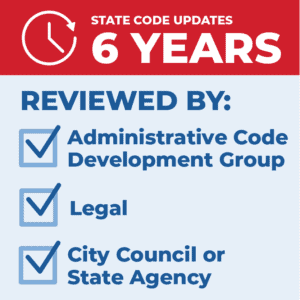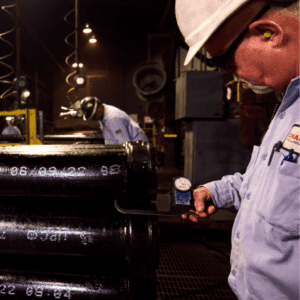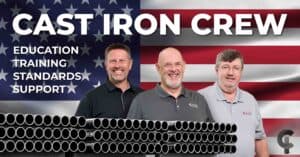Plumbing Codes
Plumbing Codes for Integrity and Life Safety of Building Construction
Plumbing Codes
Plumbing codes are important because they provide minimum regulations for the installation and inspection of plumbing systems. Plumbing codes are dedicated to ensuring the construction of safe, sustainable, and resilient structures. They ensure that everyone—from plumbing engineers and designers, construction crews and installers, to inspectors and authorities having jurisdiction (AHJ) are working from the same information.
Public safety and health are at the heart of any code – plumbing or building. Building construction codes are developed by national code development groups, as well as state and local administrative groups. Their roles are to develop codes which provide a common language and requirements for the design, construction, and operation of buildings which provides documentation and education for those who are responsible for inspecting and approving systems within the built structure.
Code Development and Governance

There are three groups that develop and govern plumbing codes:
1. International Code Council (ICC)
2. International Association of Plumbing & Mechanical Officials (IAPMO)
3. State and Local Administrative Codes
This section introduces each code body, their purpose, and a brief description of their role in the world of codes.
International Code Council (ICC)
The International Code Council (ICC) The International Code Council (ICC) was established in 1994 and set out to develop a single set of national model construction codes. This new organization brought together three different groups that had each developed their own set of model codes throughout the United States: Building Officials and Code Administrators International, Inc (BOCA), International Conference of Building Officials (ICBO) and the Southern Building Code Congress International, Inc. (SBCCI).
ICC includes a set of building safety solutions and relies on the expertise of those who author the international codes and standards and the application of them to product evaluation, accreditation, certification, training, and technology.
International Association of Plumbing & Mechanical Officials (IAPMO)
The International Association of Plumbing & Mechanical Officials (IAPMO) The International Association of Plumbing & Mechanical Officials (IAPMO) has been in existence for around one hundred years. IAPMO is dedicated to promoting the arts and science of plumbing and mechanical building codes, the officials who are connected to those, and the interests of anyone whose responsibility it is to interpret plumbing and mechanical building laws and practices.
IAMPO’s mission is to protect the public’s health and safety by working in accordance with government and industry to develop comprehensive model codes and set practices for plumbing, mechanical, solar, and swimming pool systems.
State and local administrative codes
In addition to ICC and IAPMO, state and local administrative codes may exist in your area. For example, state plumbing codes of Illinois and Wisconsin as well as city codes such as Omaha, Nebraska are examples of the administrative code which could be amended at any time.
Code Development
By attending code development meetings, CISPI represents the domestic cast iron soil pipe industry and reviews proposed code language to ensure pipe and fitting products are referenced properly.
Additionally, Institute representatives may aid in code development by submitting changes, consulting with other groups, and working as a partner in the plumbing industry overall to ensure the health and safety of the public.
How Codes are Developed
Model code cycles run in a three-year period. During this time, all constituents can review and provide input. Once the code proposals have been submitted, code hearings are conducted. When all feedback and revisions are completed, the code is put forward for approval. The updated code will reference the year approved and adopted.

Code Adoption

For state and local bodies that amend the model code, the process can take up to six years, since the code must be reviewed by the administrative code development group. During this process amendments to the model code are proposed, reviewed, and approved. The final step in the process is legal review and approval by the city council or state agency. Sometimes there are cycles of revisions that prolong the process.
Building Performance
Plumbing codes ensure the performance of the building drain, waste, and vent system (DWV), which directly leads to life safety of the building occupants. The code specifies the correct size of pipe and fittings based on potential system demand of installed plumbing fixtures. Sizing is based on the number of fixtures, including the number of lavatories, faucets, tubs, showers, etc. Due to the low-flow of many fixtures being installed in buildings the amount of water flowing through the system is diminished and should be considered when designing and installing a plumbing DWV system. Inadequate sizing or installation of DWV systems could lead to potential health hazards due to building occupants being exposed to sewage and harmful gases.
Sizing is important to ensure proper flow of waste in a DWV system. It is important to be sure all liquid and solid waste is evacuated from the building drainage system to the building sewer and onto the sanitary district for proper disposal. If the pipe is too large, waste may be left behind impeding the flow of the system due to inadequate force of flow to carry the solid and liquid waste to the sanitary district. This can lead to blockages. If the pipe is too small or there are too many fixtures connected to a drainage system blockages could occur as well. Proper sizing is important to be sure all liquid and solid waste is evacuated from a building plumbing system so potential hazards to the building occupants can be avoided.
Building underground sewer and storm drainage systems should be installed and inspected per code requirements. The requirements include but are not limited to trench width, bedding materials and compaction of backfill based on pipe material and size installed. Adhering to the requirements of the codes and standards will help limit pipe movement and deflection ensuring proper flow of waste, limiting system blockages or failure.
The Cast Iron Soil Pipe Institute and Codes

The Institute works with all code development groups to educate on the benefits of cast iron DWV products and standards to be sure they are not prohibited in plumbing, mechanical, and building codes, and to ensure cast iron soil pipe and fitting products can be used in any appropriate application.
The Institute works to ensure cast iron soil pipe products are not prohibited for use in building plumbing and mechanical systems due to incorrect technical justification. Another key role is to maintain that all drain, waste, and vent (DWV) products are used correctly to ensure the health and safety of building occupants. To that end, the Institute provides technical information to support the design and installation of cast iron DWV systems.
CISPI Standards and Plumbing Codes
CISPI maintains two standards – CISPI 301 and CISPI 310. These standards establish the definition of the manufacturer and requirements the manufacturer must adhere to for the dimensional tolerances, mechanical and chemical properties of materials used during the production of cast iron pipe fittings and hubless couplings. The standards also identify the test methods used to determine that materials and coatings meet the requirements of the standards. Additionally, minimum inspection requirements are identified in the standards for certification by the manufacturer and third-party certifiers or inspectors if used by the manufacturer.
The standards are part of the plumbing code and once the code is formally adopted it becomes law. When cities adopt the code, local inspectors are required to enforce the adopted code for the health and safety of the building occupants.
Third-party certifiers or inspectors shall comply with the minimum inspection requirements of Annex A or Annex A1 of the ASTM and CISPI product standards identified in the code for cast iron soil pipe and fittings. This section is mandatory when third-party certification or inspection is relied on for the products. It is important to compare apples to apples.
 For example, Annex A1 is a mandatory supplementary requirement of the ASTM and CISPI standards to be applied when a manufacturer or seller of the products utilizes third-party certification. This portion of the standard requires the third-party certifier to document several key areas of quality control during production of cast iron pipe and fittings. The test reports and documentation must be available upon request to the purchaser, design professional, or the administrative authority having jurisdiction where the products are being installed. It is important that the cast iron soil pipe and fitting manufacturers conduct testing as specified in the standards and that they maintain all test documentation for seven years as required.
For example, Annex A1 is a mandatory supplementary requirement of the ASTM and CISPI standards to be applied when a manufacturer or seller of the products utilizes third-party certification. This portion of the standard requires the third-party certifier to document several key areas of quality control during production of cast iron pipe and fittings. The test reports and documentation must be available upon request to the purchaser, design professional, or the administrative authority having jurisdiction where the products are being installed. It is important that the cast iron soil pipe and fitting manufacturers conduct testing as specified in the standards and that they maintain all test documentation for seven years as required.
The Institute’s mission is to educate the industry on product standard requirements and why it is important for products to adhere to all requirements of the standards. The manufacturer of the cast iron pipe, fittings, and couplings is responsible for meeting all requirements as documented – they are not allowed to selectively choose what part of the standard to follow. Product quality and safety are at stake.
Standards and Codes Work Hand in Hand
Standards and Codes work together and need to be considered as a whole, versus standalone documents. Standards are embedded in the building construction codes. Standards specify and ensure product quality and integrity – how the product is made.
Codes include product standards and provide direction on the design and installation of plumbing systems in the built environment. Check out ICC or IAMPO’s websites to learn more about their plumbing codes and how they contribute to public safety, or consult your state or local authority having jurisdiction for information about local construction codes.
We’re Here to Help
Looking for more details on CISPI standards? Contact a member of the Cast Iron Crew for more information.

Contact Us
Need assistance or technical information on cast iron soil pipe and fittings?
Find your CISPI RepFollow Us on Facebook
Follow the Institute on Facebook for current industry events and more information on cast iron soil pipe and fittings.
Follow UsFollow Us on Instagram
Follow CISPI on Instagram for weekly posts about the benefits of using cast iron soil pipe and fittings in your DWV system.
Follow UsContact Us
Need assistance or technical information on cast iron soil pipe and fittings?
Find your CISPI RepFollow Us on Facebook
Follow the Institute on Facebook for current industry events and more information on cast iron soil pipe and fittings.
Follow UsFollow Us on Instagram
Follow CISPI on Instagram for weekly posts about the benefits of using cast iron soil pipe and fittings in your DWV system.
Follow Us